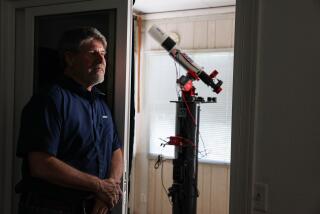Swift Sets Out on a Little Cosmic Detective Work
- Share via
The Swift spacecraft launched into orbit Saturday, carrying a payload of scientific instruments designed to probe some of the most powerful -- and fleeting -- explosive forces in the universe.
After delays caused by weather and an equipment malfunction on the venerable Delta II launch vehicle, the rocket lifted off shortly after noon from Kennedy Space Center in Florida.
The 20-foot-tall spacecraft successfully separated from the rocket booster a little more than an hour later, NASA announced.
Orbiting Earth at 325 miles, the nimble Swift spacecraft will try to unravel one of the strangest phenomena in the cosmos, an awesome fireworks display known as a gamma-ray burst. These bursts of energy, which occur almost daily in some corner of the universe, are the most intense bursts of electromagnetic radiation ever measured.
The gamma-ray bursts it will try to catch “burn as brightly as a billion, billion suns,” said Anne Kinney, director of the universe division at NASA. Although not visible to the naked eye, in the few seconds before they flicker out they release more energy than the sun will in its lifespan.
During its two-year mission, Swift is expected to pinpoint as many as 150 bursts. It is expected to take at least four months to activate and calibrate the instruments on board, at which point the spacecraft will begin serious work.
Gamma-ray bursts “are the most amazing phenomena in astrophysics,” said Neil Gehrels, the principal investigator for Swift at NASA’s Goddard Space Flight Center in Maryland.
The problem is they are also among the most fleeting cosmological events. Some last only milliseconds, while the longest recorded burst only went on for 100 seconds. That’s what has made them so difficult to study. By the time astronomers could focus in on them, they were gone.
This is why space scientists are not even certain what causes them. Speculation ranges from collisions between neutron stars, or even black holes. More adventurous theoreticians think the evaporation of a black hole might also cause a burst of gamma energy. The current favorite explanation is that they represent the death throes of the first generation of giant stars that formed shortly, in cosmological terms, after the big bang.
The $239-million Swift mission -- a collaboration between NASA, Britain and Italy -- may solve the riddle.
Using sophisticated capture-and-focus equipment consisting of six different reaction wheels and specially designed software, Swift will pivot nimbly in space. If all works as it should, Swift will home in on a gamma-ray burst in as little as 20 seconds.
“For the first time, we will be observing [bursts] when they are really bright,” said Gehrels. “Swift is fine-tuned to quickly locate these bursts and study them in several different wavelengths before they disappear forever.”
Although the night sky appears to be a place of pastoral symmetry, it’s a false front, scientists say. If humans could see the sky with gamma-ray vision, the heavens would be transformed into a place of unimaginable tumult.
Compared with other forms of electromagnetic radiation -- radio waves, infrared, visible light, ultraviolet and X-rays -- gamma-rays are the most energetic, with the highest frequencies and shortest wavelengths. They would present a serious hazard to life on Earth if the atmosphere did not prevent them from reaching the surface.
The discovery of gamma bursts in the heavens was a fluke. The Air Force launched its Vela satellite in the mid-1960s to keep an eye on the Soviets’ adherence to the recently signed nuclear test ban treaty. In July 1967, the satellite captured a gamma-ray burst, a telltale sign of nuclear testing. Only it didn’t come from Earth, but from the interstellar wastes.
Defense officials were so dumbstruck that they quickly classified the discovery and didn’t release it to the public for years. “It took quite a while to understand what we were seeing,” Gehrels said.
Past efforts to study the phenomenon have yielded some hints about what’s going on. From NASA’s Compton Gamma Ray Observatory, which detected 2,700 bursts over nine years, scientists learned that the bursts were originating far outside the Milky Way galaxy.
Several years ago, a Dutch-Italian satellite detected an X-ray “afterglow” following the gamma burst. This enabled scientists for the first time to accurately calculate the size of an energy burst. They found it was an astonishing 1,000 times more luminous than a quasar, a class of very distant stars that are more luminous than entire galaxies.
The European Space Agency’s XMM-Newton satellite later found silicon, sulfur and argon in the gas shell around a burst, convincing scientists that at least some gamma-ray bursts occur when a massive star collapses, explodes into a supernova and then shrinks to a black hole, those massive, invisible sinkholes at the center of many galaxies.
Some investigators theorize that the stellar explosions producing gamma-ray bursts may reach back to the very beginnings of the universe, when the first giant stars were being formed.
“We think these would have been the first generation of stars that created the first light in the universe,” Gehrels said.
One piece of evidence is that the earliest stars to light up the firmament would have been among the most massive, thereby capable of producing massive bursts of energy when they exploded. Space scientists also theorize that the earliest stars would have been made of the simplest elements, namely hydrogen and helium. Any star composed only of those two elements would be volatile.
Though no bursts have been detected in the Milky Way, some scientists think that if one had occurred in our neighborhood, it would have been a cataclysmic event, causing the kind of mass extinction that has occurred on Earth from time to time over geological history.
Swift’s primary early-warning instrument is a burst alert telescope, a kind of fishing net that ranges over wide swaths of the sky in search of bursts as they occur. This instrument should locate several bursts a week.
Two other instruments, an X-ray telescope and an ultraviolet optical telescope, will gather data about their host galaxies to determine if theories about their being linked to the universe’s founding father stars are correct.
Swift was originally set to launch in September, but was delayed after a series of hurricanes passed through Cape Canaveral, damaging some of the facilities and requiring mission controllers to box up the spacecraft to keep it from harm.




